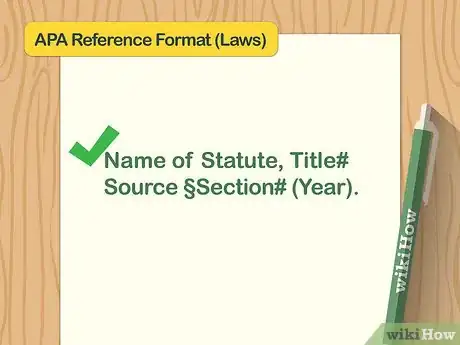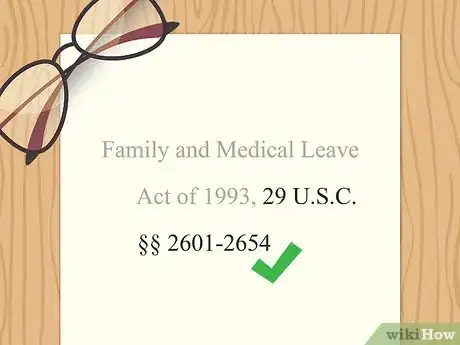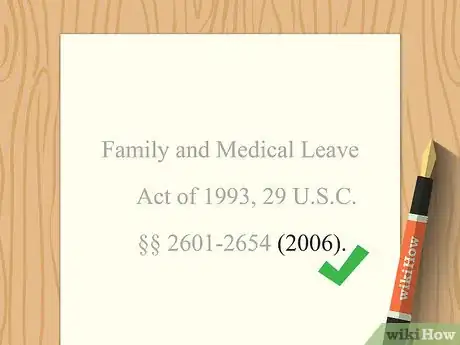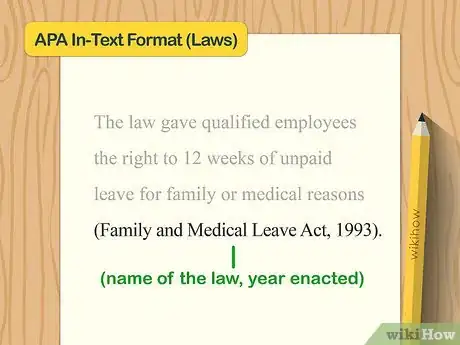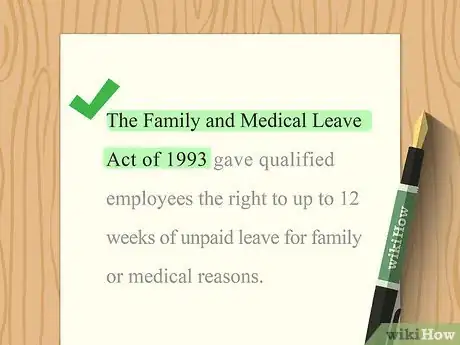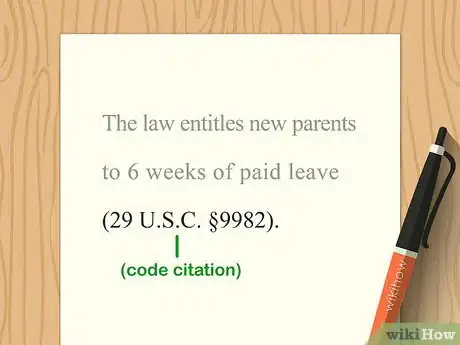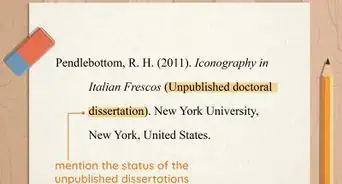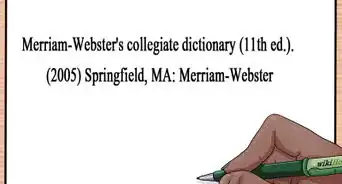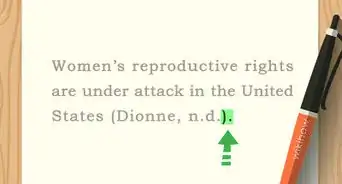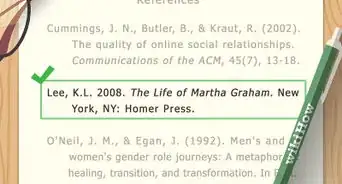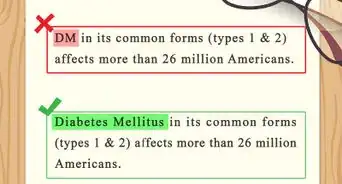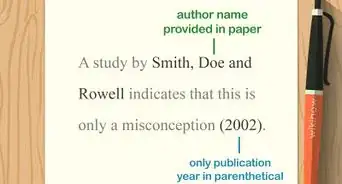This article was co-authored by wikiHow staff writer, Jennifer Mueller, JD. Jennifer Mueller is an in-house legal expert at wikiHow. Jennifer reviews, fact-checks, and evaluates wikiHow's legal content to ensure thoroughness and accuracy. She received her JD from Indiana University Maurer School of Law in 2006.
This article has been viewed 23,518 times.
Learn more...
Although you may be skilled at locating and citing resources in your field of study, legal research can present some different challenges. American Psychological Association (APA) style generally follows The Bluebook citation format for legal resources, including laws. This is the style used in the study and practice of law. When it comes to citing legislation, the format is fairly straightforward and doesn't require a lot of the information you may be used to needing for a typical APA citation.[1]
Steps
Reference List Entry
-
1Start your entry with the name of the law. Type the common name of the law in title case, capitalizing the first word as well as all nouns, pronouns, adjectives, verbs, and adverbs in the title. Place a comma at the end of the title.[2]
- Example: Family and Medical Leave Act of 1993,
-
2Add the code name and section where the law was codified. You typically can copy this information directly from the law itself if you look it up on a legislative website. Follow the same format as the source uses, including abbreviations. Place a period at the end of the section number.[3]
- Example: Family and Medical Leave Act of 1993, 29 U.S.C. §§ 2601-2654
- If you can't find the code abbreviations on the law itself, check https://www.law.cornell.edu/citation/3-300 to find the abbreviation you need.
Advertisement -
3Close your entry with the year the code was published. Pay close attention and make sure you're using the year the code was published, not the year the law was enacted. Particularly if the law was enacted long ago, they will likely be different. Place this date in parentheses at the end of your citation, followed by a period outside the closing parenthesis.[4]
- Example: Family and Medical Leave Act of 1993, 29 U.S.C. §§ 2601-2654 (2006).
APA Reference List Format – Laws
Name of Statute, Title# Source §Section# (Year).
In-Text Citation
-
1Use the common name of the law and the year the law was enacted. APA style requires a parenthetical citation at the end of any sentence in which you paraphrase or quote a source. For a law, that parenthetical citation includes the common name of the law and the year the law was enacted.[5]
- For example, you might write "The law gave qualified employees the right to 12 weeks of unpaid leave for family or medical reasons (Family and Medical Leave Act, 1993)."
Tip: Note that the date in your parenthetical citation differs from the date in your reference list entry. Your in-text citation uses the date the law was enacted, not the publication date for the code.
-
2Omit a parenthetical citation if you incorporate the information in your text. If you include the common name of the law in the body of your paper, there's no need to include it in a parenthetical citation at the end of the sentence. If you include the common name of the law and the year the law was enacted in the text of the sentence, you don't need a parenthetical citation at all.[6]
- For example, you might write "The Family and Medical Leave Act of 1993 gave qualified employees the right to up to 12 weeks of unpaid leave for family or medical reasons."
-
3Use the code citation if no common name is available. Some laws don't have a common name that you can use. In that case, you typically would include just the code citation in parentheses at the end of any sentence in which you quoted or paraphrased the law.
- For example, you might write "The law entitles new parents to 6 weeks of paid leave (29 U.S.C. §9982)."
Tip: If there's no common name and you're providing the code citation as an in-text citation, it may make sense not to have a reference list entry. Ask your instructor or supervisor for clarification.
References
- ↑ https://blog.apastyle.org/apastyle/2013/03/finding-federal-statutes.html
- ↑ https://library.csustan.edu/apalegal
- ↑ https://library.csustan.edu/apalegal
- ↑ https://blog.apastyle.org/apastyle/2013/02/writing-references-for-federal-statutes.html
- ↑ https://guides.library.cornell.edu/c.php?g=134360&p=881315
- ↑ https://guides.library.cornell.edu/c.php?g=134360&p=881315
- ↑ http://uscode.house.gov/popularnames/popularnames.htm
